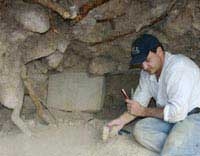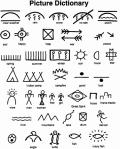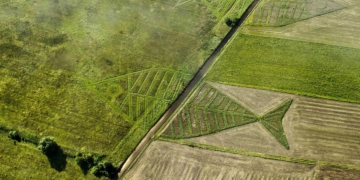In 1824, scientists identified and named the first known dinosaur, Megalosaurus. However, over the past 200 years, research into this ancient creature has remained in the exploratory phase.
In 2024, the Natural History Museum in London and the Geological Society of London will host special events to celebrate the 200th anniversary of the discovery and naming of the first dinosaur – Megalosaurus. This occasion serves as a moment for the scientific community to reflect on the knowledge gained in this field over the past two centuries.
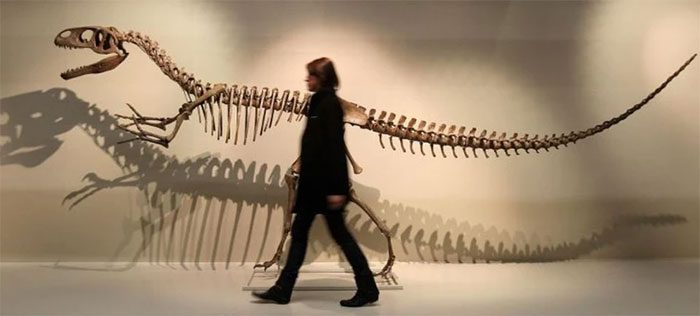
Paleontologists believe Megalosaurus walked on two legs. (Photo: PA/AP).
Looking back to the 1600s, scientists of that era were quite surprised and puzzled when they discovered fossilized bones of a gigantic creature in slate quarries in Oxfordshire, England.
At a time when the concepts of “evolution” and “extinction” had not yet emerged, researchers speculated that these fossils might belong to a Roman war elephant, or even hypothesized that they were the remains of a giant human.
It wasn’t until 1824 that William Buckland, the first Professor of Geology at the University of Oxford, after studying the fossils, identified and named this species Megalosaurus, or “great lizard,” based on the structure and size of the fossilized jawbone, vertebrae, and limb bones. (Megalosaurus had the largest femur measuring 83.82 cm long with a circumference of nearly 25.5 cm).
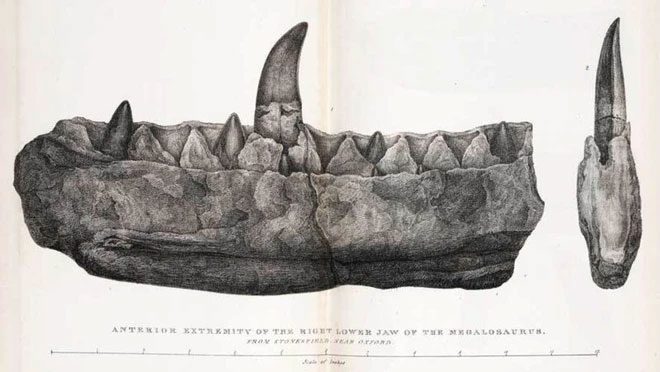
The jaw of Megalosaurus depicted in an engraving based on a drawing from 1824 by Mary Morland. (Photo: Alamy).
In a scientific paper presented to the Geological Society in London on February 20, 1824, Professor Buckland analyzed the shape of Megalosaurus’s teeth and concluded that it was a carnivorous animal over 12 meters long, possibly amphibious, capable of living both on land and in water.
Paleontologist Steve Brusatte from the University of Edinburgh, author of The Rise and Fall of Dinosaurs: A New History of a Lost World, agrees with Professor Buckland’s assessments, stating that this was a giant reptile that has since gone extinct.
Thus, Megalosaurus is indeed the first known dinosaur, but it wasn’t until 20 years later that the term “dinosaur” was coined by anatomist Richard Owen, the founder of the Natural History Museum in London.
He used this term based on the common characteristics he identified in his studies of Megalosaurus and two other dinosaurs, Iguanodon and Hylaeosaurus, which were described in 1825 and 1833, respectively.
The scientific research on Megalosaurus solidified Professor Buckland’s professional reputation in the emerging field of geology, but it was only later that it was recognized as “the first scientific description of a dinosaur.”
At that time, the individual fossil bones of Megalosaurus did not attract the same attention as the complete fossils of giant marine reptiles such as Ichthyosaurus and Plesiosaurus, discovered by paleontologist Mary Anning on the coast of England.
Nevertheless, Megalosaurus left its mark on popular culture, inspiring writer Charles Dickens to include it in the introduction of his novel Bleak House, published in 1852.
In 1854, Megalosaurus was one of three dinosaur models erected in Crystal Palace Park in London – the first dinosaur park in the world, which still exists today.

The Megalosaurus dinosaur model in Crystal Palace Park, London, erected in 1854. Paleontologists at the time believed this prehistoric creature walked on four legs. (Source: Alamy Stock Photo).
The 1854 model of Megalosaurus had a relatively accurate head shape, but later studies revealed that this dinosaur was approximately 6 meters long and walked on two legs instead of four.
Although discovered after its extinction and once regarded as a failure in the evolutionary process, dinosaurs actually existed and thrived for 165 million years – much longer than the roughly 300,000 years humans have inhabited this planet.
Today, around 1,000 species of dinosaurs have been named, with approximately 50 new species being discovered each year.
Paleontologist Brusatte noted that despite 200 years of research, scientists have only uncovered a tiny fraction of the dinosaurs that once lived. Research on these ancient creatures remains in the exploratory stage.
He stated: “Modern birds are descendants of dinosaurs, and there are currently over 10,000 species of birds in existence. Dinosaurs existed for 150 million years, so there could be thousands, even millions of different dinosaur species.”
In the 1990s, fossils excavated in China clearly revealed that some dinosaurs had feathers, confirming a hypothesis that they were direct ancestors of birds.
In addition to fossil discoveries, new technologies such as CT scans and modern computational methods also allow paleontologists to reconstruct and understand dinosaurs in much greater detail and accuracy.
For instance, in feathered fossils, the preservation of tiny structures called melanosomes, which once contained pigments, enables scientists to compare them with feather structures of modern birds, revealing the original colors of the fossilized feathers.
However, much about dinosaurs remains unexplored, such as why they evolved to such large sizes and the sounds they may have made.









































